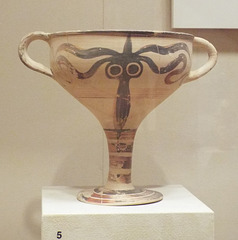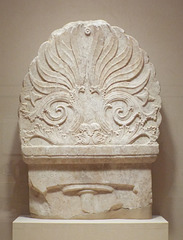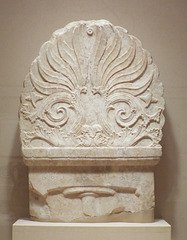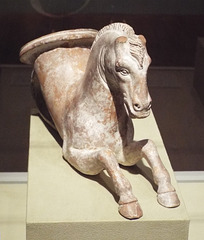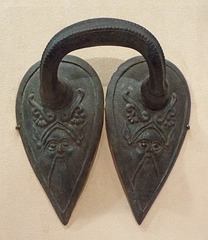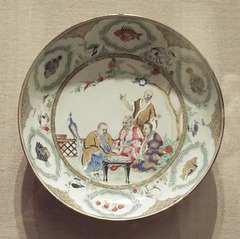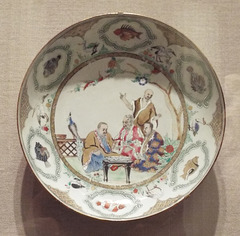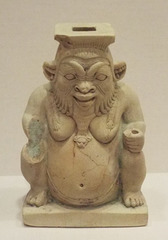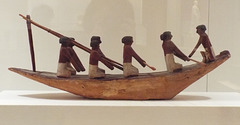
Virginia Museum of Fine Arts
Horse Rhyton in the Virginia Museum of Fine Arts,…
| |
|
Greek (South Italian, Apulia)
Horse Rhyton, 399-300 BC
Terracotta
On loan from the University of Pennsylvania Museum of Archaeology and Anthropology, Philadelphia, PA (MS2250)
Text from the Virginia MFA museum label.
Kylix with Octopus Decoration in the Virginia Muse…
| |
|
Goblet with Octopus Decoration
Unknown (Artist)
Date: 13th century BC
Culture: Mycenaean
Category: Ceramics
Containers-Vessels
Medium: terracotta
Collection: Ancient Art
Dimensions: Overall (at handles): 6 1/2 × 8 3/8 in. (16.51 × 21.27 cm)
Object Number: 60.26
The Mycenaeans, like the Minoans, painted a wide range of sea creatures on their pottery, especially octopuses. Over time Mycenaean artists produced ever simpler and more abstract depictions of octopuses.
Text from: www.vmfa.museum/piction/6027262-161358053
Kylix with Octopus Decoration in the Virginia Muse…
| |
|
Goblet with Octopus Decoration
Unknown (Artist)
Date: 13th century BC
Culture: Mycenaean
Category: Ceramics
Containers-Vessels
Medium: terracotta
Collection: Ancient Art
Dimensions: Overall (at handles): 6 1/2 × 8 3/8 in. (16.51 × 21.27 cm)
Object Number: 60.26
The Mycenaeans, like the Minoans, painted a wide range of sea creatures on their pottery, especially octopuses. Over time Mycenaean artists produced ever simpler and more abstract depictions of octopuses.
Text from: www.vmfa.museum/piction/6027262-161358053
Flame Palmette Finial for a Funerary Stele in the…
| |
|
Flame-Palmette Finial for a Funerary Stele
Unknown (Artist)
Date: mid-4th century BC
Culture: Greek (Attic)
Category: Sculpture
Medium: marble
Collection: Ancient Art
Geography: Attica, Greece
Dimensions: Overall: 29 × 18 1/2 × 4 1/2 in. (73.66 × 46.99 × 11.43 cm)
Object Number: 79.148
This style of the palmette became common in Athenian funerary art in the 4th century. The lower part of the stele (pillar) was decorated with a depiction of a loutophoros (a vessel used for water in wedding and funerary rituals), only the top of which survives. The inscription was carved freehand using letter forms typical of the mid-4th century.
Additional Information
Inscription: Inscribed: Philoneios of Prosopalta
Credit Line: Arthur and Margaret Glasgow Fund
Published References:
Mayo, Margaret Ellen, and Heather S. Russell. Ancient Art: Virginia Museum of Fine Arts. Richmond, VA: Virginia Museum of Fine Arts, 1998. (pp. 58-59)
Text from: www.vmfa.museum/piction/6027262-12954197
Flame Palmette Finial for a Funerary Stele in the…
| |
|
Flame-Palmette Finial for a Funerary Stele
Unknown (Artist)
Date: mid-4th century BC
Culture: Greek (Attic)
Category: Sculpture
Medium: marble
Collection: Ancient Art
Geography: Attica, Greece
Dimensions: Overall: 29 × 18 1/2 × 4 1/2 in. (73.66 × 46.99 × 11.43 cm)
Object Number: 79.148
This style of the palmette became common in Athenian funerary art in the 4th century. The lower part of the stele (pillar) was decorated with a depiction of a loutophoros (a vessel used for water in wedding and funerary rituals), only the top of which survives. The inscription was carved freehand using letter forms typical of the mid-4th century.
Additional Information
Inscription: Inscribed: Philoneios of Prosopalta
Credit Line: Arthur and Margaret Glasgow Fund
Published References:
Mayo, Margaret Ellen, and Heather S. Russell. Ancient Art: Virginia Museum of Fine Arts. Richmond, VA: Virginia Museum of Fine Arts, 1998. (pp. 58-59)
Text from: www.vmfa.museum/piction/6027262-12954197
Horse Rhyton in the Virginia Museum of Fine Arts,…
| |
|
Greek (South Italian, Apulia)
Horse Rhyton, 399-300 BC
Terracotta
On loan from the University of Pennsylvania Museum of Archaeology and Anthropology, Philadelphia, PA (MS2250)
Text from the Virginia MFA museum label.
Horse Rhyton in the Virginia Museum of Fine Arts,…
| |
|
Greek (South Italian, Apulia)
Horse Rhyton, 399-300 BC
Terracotta
On loan from the University of Pennsylvania Museum of Archaeology and Anthropology, Philadelphia, PA (MS2250)
Text from the Virginia MFA museum label.
Cycladic Female Figure in the Virginia Museum of F…
| |
|
Female Figure (Primary Title)
Unknown (Artist)
Date: 3rd millenium B.C., ca. 2400 BC
Culture: Cycladic
Category: Sculpture
Medium: marble
Collection: Ancient Art
Dimensions: Overall: 14 3/4 × 4 1/4 × 1 1/2 in. (37.47 × 10.8 × 3.81 cm)
Object Number: 83.73
The eyes, hair, and jewelry on this figure were painted with blue and red pigments, traces of which are still visible. Typically the mouths of such figures were not shown.
Text from: www.vmfa.museum/piction/6027262-62229041
Cycladic Female Figure in the Virginia Museum of F…
| |
|
Female Figure (Primary Title)
Unknown (Artist)
Date: 3rd millenium B.C., ca. 2400 BC
Culture: Cycladic
Category: Sculpture
Medium: marble
Collection: Ancient Art
Dimensions: Overall: 14 3/4 × 4 1/4 × 1 1/2 in. (37.47 × 10.8 × 3.81 cm)
Object Number: 83.73
The eyes, hair, and jewelry on this figure were painted with blue and red pigments, traces of which are still visible. Typically the mouths of such figures were not shown.
Text from: www.vmfa.museum/piction/6027262-62229041
Etruscan Stamnos Handle in the Virginia Museum of…
| |
|
Stamnos Handle with Satyr Head Plates (Primary Title)
Unknown (Artist)
Date: 5th-4th century BC
Culture: Etruscan
Category: Metalwork
Medium: bronze
Collection: Ancient Art
Dimensions: Overall: 6 1/4 × 5 5/8 × 2 1/2 in. (15.88 × 14.29 × 6.35 cm)
Object Number: 82.202
This handle was probably attached to a stamnos (a type of storage vessel frequently used as a cinerary urn). Lance-shaped leaves are common on such handles, usually decorated (as here) with floral motifs and head of a silenus, one of the followers of Dionysos.
Text from: www.vmfa.museum/piction/6027262-8119489
Etruscan Stamnos Handle in the Virginia Museum of…
| |
|
Stamnos Handle with Satyr Head Plates (Primary Title)
Unknown (Artist)
Date: 5th-4th century BC
Culture: Etruscan
Category: Metalwork
Medium: bronze
Collection: Ancient Art
Dimensions: Overall: 6 1/4 × 5 5/8 × 2 1/2 in. (15.88 × 14.29 × 6.35 cm)
Object Number: 82.202
This handle was probably attached to a stamnos (a type of storage vessel frequently used as a cinerary urn). Lance-shaped leaves are common on such handles, usually decorated (as here) with floral motifs and head of a silenus, one of the followers of Dionysos.
Text from: www.vmfa.museum/piction/6027262-8119489
Etruscan Wine Funnel with Strainer in the Virginia…
| |
|
Wine Funnel with Strainer (Primary Title)
Unknown (Artist)
Date: 6th century BC
Culture: Etruscan
Category: Metalwork
Medium: copper alloy
Collection: Ancient Art
Dimensions: Overall: 5 1/4 × 4 1/4 × 12 3/4 in. (13.34 × 10.8 × 32.39 cm)
Object Number: 79.70
Ancient wines were not filtered, so strainers were essential kitchen implements. This elegant example Is one of a small group of bronzes produced in the 6th century that combine a colander with a funnel. Here functionality is wed to elegance in such details as the duck’s head handle.
Text from: www.vmfa.museum/piction/6027262-8111630
Etruscan Wine Funnel with Strainer in the Virginia…
| |
|
Wine Funnel with Strainer (Primary Title)
Unknown (Artist)
Date: 6th century BC
Culture: Etruscan
Category: Metalwork
Medium: copper alloy
Collection: Ancient Art
Dimensions: Overall: 5 1/4 × 4 1/4 × 12 3/4 in. (13.34 × 10.8 × 32.39 cm)
Object Number: 79.70
Ancient wines were not filtered, so strainers were essential kitchen implements. This elegant example Is one of a small group of bronzes produced in the 6th century that combine a colander with a funnel. Here functionality is wed to elegance in such details as the duck’s head handle.
Text from: www.vmfa.museum/piction/6027262-8111630
Plate with a Scene of Doctors' Visit in the Virgin…
| |
|
Plate with Scene of Doctors' Visit (Primary Title)
Cornelius Pronk, Dutch, 1691 - 1759 (Designer)
Date: 1735-40
Culture: Dutch
Category: Ceramics
Medium: Porcelain with famille rose enamels
Collection: East Asian Art
Dimensions: Overall: 1 7/8 × 9 3/4 in. (4.76 × 24.77 cm)
Object Number: 72.34.2
Related Material: Pair with "Plate with Scene of Doctors' Visit" (72.34.1)
In the mid-1730s, Cornilis Pronk of Amsterdam was commissioned by the Dutch East India Company to design a number of ceramics on the subject of life in China. To make this vessel, a white ceramic was produced in Jingdezhen, transferred to Guangzhou for painting, and then shipped to Europe.
Text from: www.vmfa.museum/piction/6027262-8094449
Plate with a Scene of Doctors' Visit in the Virgin…
| |
|
Plate with Scene of Doctors' Visit (Primary Title)
Cornelius Pronk, Dutch, 1691 - 1759 (Designer)
Date: 1735-40
Culture: Dutch
Category: Ceramics
Medium: Porcelain with famille rose enamels
Collection: East Asian Art
Dimensions: Overall: 1 7/8 × 9 3/4 in. (4.76 × 24.77 cm)
Object Number: 72.34.2
Related Material: Pair with "Plate with Scene of Doctors' Visit" (72.34.1)
In the mid-1730s, Cornilis Pronk of Amsterdam was commissioned by the Dutch East India Company to design a number of ceramics on the subject of life in China. To make this vessel, a white ceramic was produced in Jingdezhen, transferred to Guangzhou for painting, and then shipped to Europe.
Text from: www.vmfa.museum/piction/6027262-8094449
Vessel in the Form of Bes in the Virginia Museum o…
| |
|
Vessel in the form of the God Bes (Primary Title)
Unknown (Artist)
Date: 650-550 BC
Culture: Egyptian
Category: Ceramics, Containers-Vessels
Medium: faience
Collection: Ancient Art
Dimensions: Overall: 5 5/8 × 3 25/32 × 3 3/8 in. (14.29 × 9.6 × 8.57 cm)
Object Number: 93.110
The animal-headed god Bes was a household deity who guided women and children through the perils of pregnancy, childbirth, and infancy. This Bes wears a leopard skin arranged around his neck, a feature that appeared during the Nubian rule of Egypt (Dynasty 25). This vessel once had a lid in the form of Bes’s tall feathered headdress.
Text from: www.vmfa.museum/piction/6027262-8177537
Vessel in the Form of Bes in the Virginia Museum o…
| |
|
Vessel in the form of the God Bes (Primary Title)
Unknown (Artist)
Date: 650-550 BC
Culture: Egyptian
Category: Ceramics, Containers-Vessels
Medium: faience
Collection: Ancient Art
Dimensions: Overall: 5 5/8 × 3 25/32 × 3 3/8 in. (14.29 × 9.6 × 8.57 cm)
Object Number: 93.110
The animal-headed god Bes was a household deity who guided women and children through the perils of pregnancy, childbirth, and infancy. This Bes wears a leopard skin arranged around his neck, a feature that appeared during the Nubian rule of Egypt (Dynasty 25). This vessel once had a lid in the form of Bes’s tall feathered headdress.
Text from: www.vmfa.museum/piction/6027262-8177537
Egyptian Boat Model in the Virginia Museum of Fine…
| |
|
Boat Model (Primary Title)
Unknown (Artist)
Date: 2010 - 1961 BC
Culture: Egyptian
Category:Sculpture
Medium: wood coated with plaster, painted
Collection: Ancient Art
Dimensions: Overall: 9 1/4 × 4 3/4 × 28 in. (23.495 × 12.065 × 71.12 cm)
Object Number: 53.30.3
Miniatures showing scenes of daily life were often placed in tombs during the Middle Kingdom. The large number of boat models reflects the Nile’s importance in Egyptian life: the river was Egypt’s main road and main source of food (fish and waterfowl).
Boats were also important in funerary rituals and myths. A burial usually included two or more boat models, at least one rigged for sailing (south, upstream on the Nile) and another for rowing (north, downstream). This model comes from the tomb of Djehuty-nakht, which contained fifty-five boat models, probably the largest group found in any Middle Kingdom tomb.
Text from: www.vmfa.museum/piction/6027262-12951893
Jump to top
RSS feed- Latest items - Subscribe to the latest items added to this album
- ipernity © 2007-2024
- Help & Contact
|
Club news
|
About ipernity
|
History |
ipernity Club & Prices |
Guide of good conduct
Donate | Group guidelines | Privacy policy | Terms of use | Statutes | In memoria -
Facebook
Twitter


